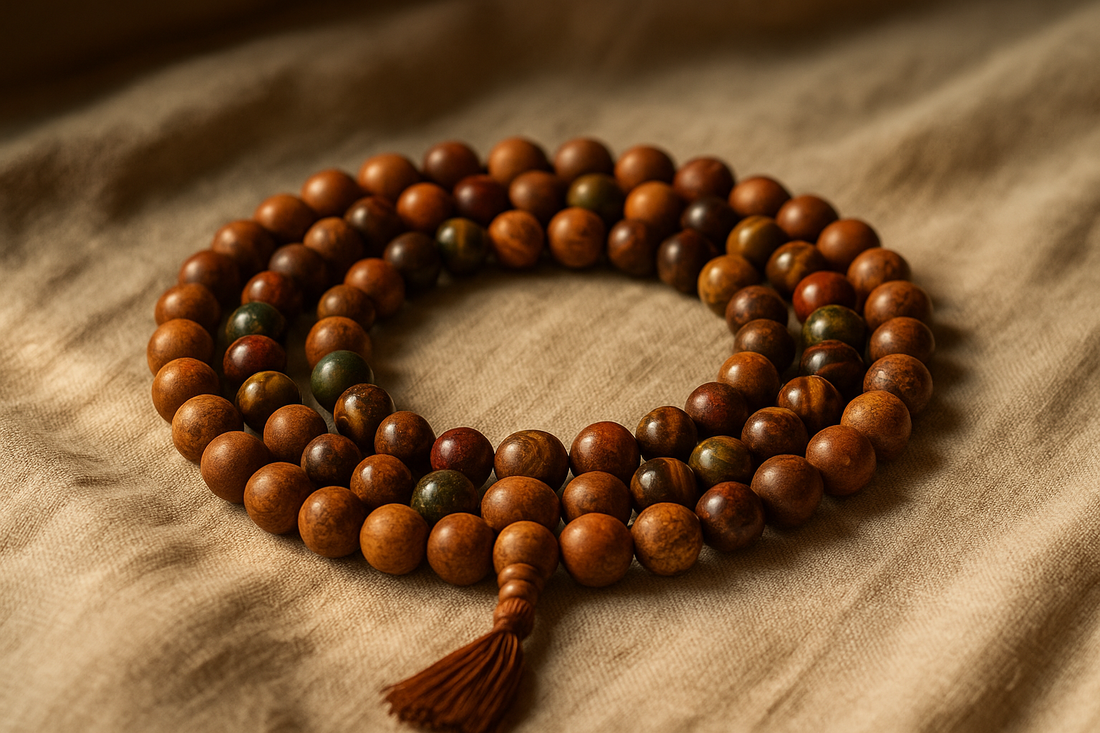
Prayer Beads: Types, Origins, Uses, and Care (A No-Fluff Guide)
Share
Prayer beads are simple tools with a deep purpose: they help the hands count so the mind can stay present.
Below is a practical guide to what they are, where they come from, how to use and wear them daily, and how to care for different materials.
What are prayer beads—and why are they round?
At heart, prayer beads are counters. Each bead marks a breath, mantra, verse, or intention. The round shape rolls smoothly between the fingers, offering even spacing and a steady rhythm.
Roundness also symbolizes cycles—breath in/breath out, dawn/dusk, birth/renewal—which is why circles show up across spiritual traditions.

Cultural origins (the short tour)
Prayer-bead practice appears in many places, often independently:
- India & Tibet: Japa malas in Hinduism and Buddhism (often 108 beads) for mantra recitation; Tibetan malas may add metal “counters.”
- East Asia (China, Japan, Korea): Buddhist malas/juzu with 108 or shorter derivations (e.g., 27×4).
- Middle East & the Islamic world: Misbaha/tasbih with 99 (or 33×3) beads to recite divine names.
- Christian traditions: The Catholic rosary (typically 59 beads) and the Orthodox prayer rope (komboskini, knotted rather than beaded).
- Sikh tradition: Mala for simran (remembrance).
- Greece & the Mediterranean: Komboloi (“worry beads”), often secular for relaxation.
Different counts reflect different devotions, but the hand–mind rhythm is the common thread.
How many kinds are on the market?
Plenty—and most fall into these families:
- Full malas/rosaries (long strands you loop over the neck or wrap on the wrist).
- Wrist malas (stretch or cord, typically 18–27 beads).
- Prayer ropes (knots instead of beads).
- Komboloi/relaxation beads (no fixed count, used for fidgeting or pacing).
- Theme pieces (gemstone-specific sets for grounding, calm, or focus).
Counts you’ll commonly see: 108, 99, 59, 54, 33, 27, 21, and 18.

When and how to use prayer beads
Use prayer beads to pace:
- Breath work: one bead per inhale–exhale cycle.
- Mantra/affirmation: one phrase per bead; pause at the marker bead to reset.
- Walking meditation: thumb along a bead every few steps.
- Quiet rituals: pair with soft lighting or a single stick of incense to anchor attention (if you enjoy scent, see our curated incense sticks).
Sessions can be three minutes or thirty; the beads simply hold the count so you can hold the moment.
Can you wear them daily?
Yes—with intention. Many people wear prayer beads on the wrist or around the neck as a reminder to pause. Daily wear is fine if you avoid hard knocks, chemicals, and water exposure (details by material below). In formal services, follow your tradition’s etiquette (e.g., remove hats, handle beads respectfully, avoid using them as fashion props during prayer).
Materials and what to watch out for
Different materials behave differently. Quick, practical notes:
Wood (sandalwood, rosewood, ebony, olive, bodhi seed)
- Feel: warm, light, aromatic (some).
- Care: avoid soaking; wood absorbs water and oils. Wipe with a dry cloth; a touch of natural oil can refresh matte finishes. Keep away from perfume and hair spray.
Seeds & nuts (rudraksha, bodhi, lotus seeds)
- Feel: textured, very light.
- Care: keep dry; prolonged moisture can swell fibers or darken unevenly. Don’t scrub; use a soft brush to clean grooves.
Gemstones (amethyst, quartz, snowflake obsidian, jade, etc.)
- Feel: cool, heavier, glossy.
- Care: most are durable, but avoid harsh cleaners, saltwater, and extreme heat. Some stones are softer or porous (e.g., calcite, turquoise, malachite)—keep away from acids and strong sunlight that may fade color dyes.

Glass & crystal glass
- Feel: smooth, even color, often luminous.
- Care: stable but can chip on impact. Avoid temperature shocks (hot shower to cold air).
Metals (silver, brass, copper)
- Feel: weighty; can patina.
- Care: keep dry; polish gently with a dedicated cloth. Avoid chlorine and sulfur (tarnish).
Bone, horn, shell, amber, coral (heritage materials)
- Feel: warm, organic.
- Care: keep away from hot water and chemicals; support ethical sourcing. Amber softens with heat; shell can etch in acids; coral is sensitive and often protected—buy conscientiously.
Deeper meaning: what do prayer beads represent?
At a personal level, prayer beads are a tactile anchor.
They externalize counting so the mind can internalize meaning—gratitude, compassion, repentance, or calm.
The circle suggests continuity; the marker bead or tassel often symbolizes a pause, humility, or the teacher/source. Moving bead by bead mirrors progress made one small choice at a time.
Regional preferences at a glance
- South Asia/Tibet: 108-bead malas, often wood (sandalwood, bodhi) or gemstones; tassels and metal counters are common.
- East Asia: sleek wooden or seed malas; Japanese juzu often has decorative “parent beads.”
- Middle East/North Africa: 33 or 99-bead misbaha in wood, amber, or stone; often carried in hand.
- Europe/Americas: Catholic rosaries with crucifix; Anglican rosaries (33-bead pattern) for meditative prayer.
- Greece: Komboloi in amber, resin, or stone for pacing and relaxation.
Choose a style that fits your practice and your hand.
Wear & water: practical do’s and don’ts
- Bathing/shower: best to remove. Heat, soap, and shampoo dull polish, swell wood, tarnish metal, and weaken elastic.
- Swimming: avoid chlorine and saltwater—both degrade cord and finishes.
- Handwashing: brief splashes won’t destroy most beads, but it’s smarter to slide wrist malas above the wrist bone or remove them. If they get wet, pat dry and air-dry flat before storing.
- Daily handling: avoid perfume, sunscreen, hair spray, and rough surfaces; store in a soft pouch; restring yearly if you wear them often (elastic ages).
- Respect: don’t place beads on the floor; if your tradition sets rules for counting direction or how to pass the guru bead, follow them.
Final take
Prayer beads are low-tech, high-impact tools: easy to learn, calming to use, meaningful to wear.
Pick a count that matches your practice, a material that suits your lifestyle, and a ritual that invites you back to the present—one bead, one breath, one step at a time.
